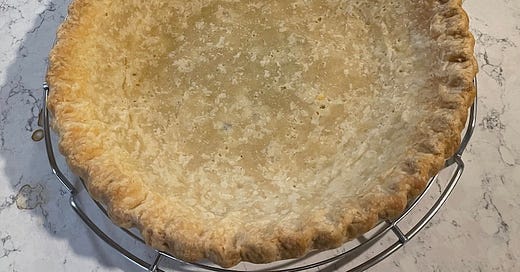Aloha, my faithful followers. It’s been awhile since my last newsletter, and here’s a new one to whet your appetites. This is an update of a previous newsletter for paid subscribers only.
When we moved to Kauai almost three years ago, I had to adjust my baking life to our new environment. Making bread needed no alterations because our room temperature ranges from the mid-seventies to the low eighties. Bread dough loves these conditions! We have no air conditioning.
Our apartment has two sets of floor-to-ceiling sliding glass doors. We keep the one in the living room and kitchen area open during the day. Propping the front door open provides a refreshing current of cross ventilation.
This video was lovingly created by Dorothy H. Patent
Recipe and Tips
Making pie dough or other fat-based pastry has its challenges here, but it can be done! The key is to have all ingredients ice cold. A food processor makes such quick work of putting the pastry together that the dough remains icy cold.
NOTE: If you’re a baker who loves to get her hands in the flour to pinch pieces of butter into flakes, this technique may still work for you in a tropical environment so long as the flour, water, and fat are ice cold and you work like the wind.
The fat in this recipe is all butter. Here’s what I do. I weigh the flour in a small stainless steel bowl, add the salt and optional sugar on top, cover the bowl with plastic wrap, and pop it into the freezer. Leave the bowl there for at least 2 hours. It can stay there for days.
Have ice water at the ready in the fridge. Cut the stick of cold butter into 8 equal pieces and refrigerate.
For a one-crust pastry, weight 5 ounces (142 grams) of bleached or unbleached all-purpose flour into your bowl and sprinkle on top ¼ teaspoon table salt or ½ teaspoon Diamond Crystal kosher salt and 1 teaspoon sugar. The sugar is optional but it does help with the browning. Cover the bowl nice and tight and put it in the freezer.
To make the pastry, have the food processor on your countertop and set the frozen flour, ice water, ice cold butter and a 1 tablespoon measure next to it.
Dump the flour, salt and sugar into the work bowl with the metal blade in place. Process 5 to 10 seconds. Add the butter pieces and pulse 4 times for 1 second each. Uncover the work bowl and add 3 tablespoons ice water. Cover and pulse very rapidly 20 times to cut the butter into smaller bits. Check the dough; it may be moist enough to begin holding together.
If not sprinkle in up to 1 tablespoon more ice water and pulse a few times very rapidly until the dough becomes moist enough to hold together when you squeeze it. Look closely into the processor as you pulse. You’ll be able to see the point where the pastry looks like it will come together when you press it. Do not let the dough gather into a ball in the processor or it may become too tough when baked.
Dump the clumps of dough out onto a lightly floured pastry cloth and press them together into a 4- to 5- inch diameter disk. Work quickly. Wrap in plastic and refrigerate. That’s it! Let the dough chill for about 2 hours if you want to use it that day. During the rest period the gluten relaxes and the pastry will be easy to roll. If you have a large food processor you can double the recipe.
Have fun!





Looks yummy! What did you put inside the crust? Chocolate cream? Cherries? Oh! Mangoes! Have you tried The Right Slice yet?
Simplicity itself! There's no excuse not to make a pie every day, no matter how hot it is.